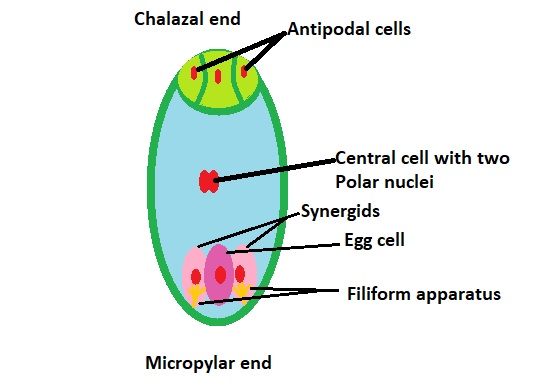Megasporogenesis is the process in which megaspores are formed within the ovules of flowering plants. In this process, the megasporocyte undergoes meiosis, resulting in four haploid megaspores. Usually, only one megaspore remains functional, which then undergoes several rounds of mitotic division to develop into the mature embryo sac or female gametophyte.

Egg Cell (1 nucleus): The female gamete, located at the micropylar end of the embryo sac, is involved in fertilization.
Synergid Cells (2 nuclei): Two synergid cells are located adjacent to the egg cell and play a role in guiding the pollen tube during pollination.
Antipodal Cells (3 nuclei): Three antipodal cells are located at the chalazal end of the embryo sac. The function of antipodal cells is not fully understood, but they are believed to be involved in supporting the development of the embryo sac.
Central Cell (2 nuclei): Positioned at the center of the embryo sac, the central cell houses two polar nuclei. These two polar nuclei will participate in triple fusion during double fertilization.
Double fertilization is a unique reproductive process in flowering plants, involving the fusion of two sperm cells with different female gametophyte nuclei.
i) Generative Syngamy (Fusion 1): One sperm cell from the pollen tube fuses with the egg cell (1 nucleus), resulting in the formation of the zygote (2n), which develops into the embryo.
ii) Vegetative Syngamy (Fusion 2): The other sperm cell from the pollen tube fuses with the two polar nuclei (2 nuclei) present in the central cell of the embryo sac. This fusion leads to the creation of the primary endosperm nucleus, which is triploid (3n).
Triple Fusion (Fusion 3):
Triple fusion is a distinctive feature of double fertilization in angiosperms. In this process, one of the sperm cells from the pollen tube merges with the two polar nuclei within the central cell of the mature embryo sac. This union forms the triploid (3n) primary endosperm nucleus, which contains three sets of chromosomes.
After the fusion of the sperm cell with the two polar nuclei, the primary endosperm nucleus initiates a series of rapid mitotic divisions. Unlike typical cell divisions, these divisions do not have cytokinesis (cell wall formation), leading to the formation of a multinucleate endosperm. As a result, the endosperm develops into a nutrient-rich tissue that supports and nourishes the growing embryo.
Endosperm is a nutritive tissue that supports the developing embryo in flowering plants. There exist three primary categories of endosperms:
i) Nuclear Endosperm: In nuclear endosperm, the primary endosperm nucleus divides repeatedly without cell division, forming a multinucleate mass within the embryo sac.
ii) Cellular Endosperm: In cellular endosperm, the primary endosperm nucleus undergoes repeated cell divisions, leading to the formation of individual cells within the embryo sac.
iii) Helobial Endosperm: This type of endosperm displays features of both nuclear and cellular types, representing a transitional form between the two. Initially, the primary endosperm nucleus undergoes free nuclear divisions, and later, cell walls form, converting it into cellular endosperm.
Each type of endosperm serves as a nutrient reservoir for the developing embryo and plays a crucial role in supporting seed development and germination.